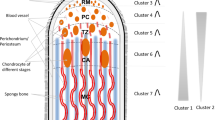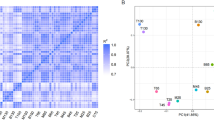Abstract
Deer antlers serve as useful models of rapid growth and mineralization in mammals. During the period of rapid growth, the antlers of many species of deer will elongate by more than 2 cm per day, after which the antlers gradually ossify. However, little is known about the genes that are involved in their development, particularly the molecular mechanisms responsible for rapid growth and ossification. In our previous studies, we have reported on the transcriptome analysis of deer antlers at rapid growth and ossification stages. With the aim to get a comprehensive understanding of gene expression patterns during antler growth, in the present study, we performed a rigorous algorithm to identify differentially expressed genes between two different stages (60 and 90 days) during antler growth. A total of 16,905 significantly changed transcripts were identified. Those sequences were mapped to 5,573 genes with 2,217 genes up-regulated and 3,356 genes down-regulated (60 days vs. 90 days), including ribosomal proteins, translation initiation and elongation factors, transcription factors, signaling molecules and extracellular matrix proteins. We also performed the gene ontology (GO) functional enrichment and pathway enrichment analysis of gene expression patterns with hypergeometric test and Bonferroni Correction. Both the two stages were enriched with members of GO categories and distinct pathways. Our data represent the most comprehensive sequence resource available for the deer antler and provide a basis for further research on deer antler molecular genetics and functional genomics.




Similar content being viewed by others
Abbreviations
- GO:
-
Gene ontology
- COG:
-
Clusters of orthologous groups
- KEGG:
-
Kyoto encyclopedia of genes and genomes
- DEGs:
-
Differentially expressed genes
References
Yao B, Zhao Y, Zhang M et al (2011) Generation and analysis of expressed sequence tags from the bone marrow of Chinese Sika deer. Mol Biol Rep 39(3):2981–2990
Szuwart T, Kierdorf H, Kierdorf U et al (2002) Histochemical and ultrastructural studies of cartilage resorption and acid phosphatase activity during antler growth in fallow deer (Dama dama). Anat Rec 268:66–72
Garcia RL, Sadighi M, Francis SM et al (1997) Expression of neurotrophin-3 in the growing velvet antler of the red deer Cervus elaphus. J Mol Endocrinol 19:173–182
Price J, Allen S (2004) Exploring the mechanisms regulating regeneration of deer antlers. Philos Trans R Soc Lond B Biol Sci 359:809–822
Wang Z, Gerstein M, Snyder M (2009) RNA-Seq: a revolutionary tool for transcriptomics. Nat Rev Genet 10:57–63
Metzker ML (2009) Sequencing technologies-the next generation. Nat Rev Genet 11:31–46
Yao B, Zhao Y, Wang Q et al (2012) De novo characterization of the antler tip of Chinese Sika deer transcriptome and analysis of gene expression related to rapid growth. Mol Cell Biochem 364:93–100
Yao B, Zhao Y, Zhang H et al (2012) Sequencing and de novo analysis of the Chinese Sika deer antler-tip transcriptome during the ossification stage using Illumina RNA-Seq technology. Biotechnol Lett 34(5):813–822
Li R, Zhu H, Ruan J et al (2010) De novo assembly of human genomes with massively parallel short read sequencing. Genome Res 20:265–272
Lee Y, Tsai J, Sunkara S et al (2005) The TIGR Gene Indices: clustering and assembling EST and known genes and integration with eukaryotic genomes. Nucleic Acids Res 33:D71–D74
Huang X, Madan A (1999) CAP3: a DNA sequence assembly program. Genome Res 9:868–877
Iseli C, Jongeneel CV, Bucher P (1999) ESTScan: a program for detecting, evaluating, and reconstructing potential coding regions in EST sequences. Proc Int Conf Intell Syst Mol Biol: 138–148
Conesa A, Götz S, García-Gómez JM et al (2005) Blast2GO: a universal tool for annotation, visualization and analysis in functional genomics research. Bioinformatics 21:3674–3676
Harris MA, Clark J, Ireland A et al (2004) The gene ontology (GO) database and informatics resource. Nucleic Acids Res 32:D258–D261
Ye J, Fang L, Zheng H et al (2006) WEGO: a web tool for plotting GO annotations. Nucleic Acids Res 34(Web Server issue):W293–W297
Tatusov RL, Natale DA, Garkavtsev IV et al (2001) The COG database: new developments in phylogenetic classification of proteins from complete genomes. Nucleic Acids Res 29:22–28
Kanehisa M, Goto S, Kawashima S et al (2004) The KEGG resource for deciphering the genome. Nucleic Acids Res 32:D277–D280
Mortazavi A, Williams BA, Mccue K et al (2008) Mapping and quantifying mammalian transcriptomes by RNA-Seq. Nat Methods 5:1–8
Audic S, Claverie JM (1997) The significance of digital gene expression profiles. Genome Res 7:986–995
Benjamini Y, Yekutieli D (2001) The control of the false discovery rate in multiple testing under dependency. Ann Stat 29:1165–1188
Livak KJ, Schmittgen TD (2001) Analysis of relative gene expression data using real-time quantitative PCR and the 2−ΔΔct method. Methods 25:402–408
Shi CY, Yang H, Wei CL et al (2011) Deep sequencing of the Camellia sinensis transcriptome revealed candidate genes for major metabolic pathways of tea-specific compounds. BMC Genomics 12:131
Wang XW, Luan JB, Li JM et al (2010) De novo characterization of a whitefly transcriptome and analysis of its gene expression during development. BMC Genomics 11:400
Dever TE (2002) Gene-specific regulation by general translation factors. Cell 108:545–556
Chen FW, Ioannou YA (1999) Ribosomal proteins in cell proliferation and apoptosis. Int Rev Immunol 18:429–448
Bortoluzzi S, d’Alessi F, Romualdi C et al (2001) Differential expression of genes coding for ribosomal proteins in different human tissues. Bioinformatics 17:1152–1157
Kowalczyk P, Woszczyński M, Ostrowski J (2002) Increased expression of ribosomal protein S2 in liver tumors, posthepactomized livers, and proliferating hepatocytes in vitro. Acta Biochim Pol 49:615–624
Hagner PR, Mazan-Mamczarz K, Dai B et al (2011) Ribosomal protein S6 is highly expressed in non-Hodgkin lymphoma and associates with mRNA containing a 5′ terminal oligopyrimidine tract. Oncogene 30:1531–1541
Kondoh N, Shuda M, Tanaka K et al (2001) Enhanced expression of S8, L12, L23a, L27 and L30 ribosomal protein mRNAs in human hepatocellular carcinoma. Anticancer Res 21:2429–2433
He H, Sun Y (2007) Ribosomal protein S27L is a direct p53 target that regulates apoptosis. Oncogene 26:2707–2716
Khanna N, Sen S, Sharma H et al (2003) S29 ribosomal protein induces apoptosis in H520 cells and sensitizes them to chemotherapy. Biochem Bioph Res Co 304:26–35
Zhang Y, Wolf GW, Bhat K et al (2003) Ribosomal protein L11 negatively regulates oncoprotein MDM2 and mediates a p53-dependent ribosomal-stress checkpoint pathway. Mol Cell Biol 23:8902–8912
Zanelli CF, Valentini SR (2007) Is there a role for eIF5A in translation? Amino Acids 33:351–835
Shahbazian D, Parsyan A, Petroulakis E et al (2010) Control of cell survival and proliferation by mammalian eukaryotic initiation factor 4B. Mol Cell Biol 30:1478–1485
Zhang L, Pan X, Hershey JWB (2007) Individual overexpression of five subunits of human translation initiation factor eIF3 promotes malignant transformation of immortal fibroblast cells. J Biol Chem 282:5790–5800
Djé MK, Mazabraud A, Viel A et al (1990) Three genes under different developmental control encode elongation factor 1-α in Xenopus laevis. Nucleic Acids Res 18:3489–3493
Xu K, Zhang Y, Ilalov K et al (2007) Cartilage oligomeric matrix protein associates with granulin-epithelin precursor (GEP) and potentiates GEP-stimulated chondrocyte proliferation. J Biol Chem 282:11347–11355
Kong L, Tian Q, Guo F et al (2010) Interaction between cartilage oligomeric matrix protein and extracellular matrix protein 1 mediates endochondral bone growth. Matrix Biol 29:276–286
Haglund L, Tillgren V, Addis L et al (2011) Identification and characterization of the integrin alpha2beta1 binding motif in chondroadherin mediating cell attachment. J Biol Chem 286:3925–3934
Zheng Q, Zhou G, Morello R et al (2003) Type X collagen gene regulation by Runx2 contributes directly to its hypertrophic chondrocyte-specific expression in vivo. J Cell Biol 162:833–842
Wilsman NJ, Farnum CE, Leiferman EM et al (1996) Differential growth by growth plates as a function of multiple parameters of chondrocytic kinetics. J Orthopaed Res 14:927–936
Gelse K, Klinger P, Koch M et al (2011) Thrombospondin-1 prevents excessive ossification in cartilage repair tissue induced by osteogenic protein-1. Tissue Eng Part A 15–16:2101–2112
Klinger P, Surmann-Schmitt C, Brem M et al (2011) Chondromodulin 1 stabilizes the chondrocyte phenotype and inhibits endochondral ossification of porcine cartilage repair tissue. Arthritis Rheum 63:2721–2731
Xu C, Zhang Z, Wu M et al (2011) Recombinant human midkine stimulates proliferation and decreases dedifferentiation of auricular chondrocytes in vitro. Exp Biol Med 236:1254–1262
Terpstra L, Prud’homme J, Arabian A et al (2003) Reduced chondrocyte proliferation and chondrodysplasia in mice lacking the integrin-linked kinase in chondrocytes. J Cell Biol 162:139–148
Grashoff C, Aszódi A, Sakai T et al (2003) Integrin-linked kinase regulates chondrocyte shape and proliferation. EMBO Rep 4:432–438
Aberger F, Weidinger G, Grunz H et al (1998) Anterior specification of embryonic ectoderm: the role of the Xenopus cement gland-specific gene XAG-2. Mech Develop 72:115–130
Brychtova V, Vojtesek B, Hrstka R et al (2011) Anterior gradient 2: a novel player in tumor cell biology. Cancer Lett 304:1–7
Kumar A, Godwin JW, Gates PB et al (2007) Molecular basis for the nerve dependence of limb regeneration in an adult vertebrate. Science 318:772–777
Newman B, Gigout LI, Sudre L et al (2001) Coordinated expression of matrix Gla protein is required during endochondral ossification for chondrocyte survival. J Cell Biol 154:659–666
Ivkovic S (2003) Connective tissue growth factor coordinates chondrogenesis and angiogenesis during skeletal development. Development 130:2779–2791
Salati S, Zini R, Bianchi E et al (2008) Role of CD34 antigen in myeloid differentiation of human hematopoietic progenitor cells. Stem cells 26:950–959
Kopher RA, Penchev VR, Islam MS et al (2010) Human embryonic stem cell-derived CD34+ cells function as MSC progenitor cells. Bone 47:718–728
Francis SM, Suttie JM (1998) Detection of growth factors and proto-oncogene mRNA in the growing tip of red deer (Cervus elaphus) antler using reverse-transcriptase polymerase chain reaction (RT-PCR). J Exp Zool 281:36–42
Fisher MC, Meyer C, Garber G et al (2005) Role of IGFBP2, IGF-I and IGF-II in regulating long bone growth. Bone 37:741–750
Horiuchi K, Amizuka N, Takeshita S et al (1999) Identification and characterization of a novel protein, periostin, with restricted expression to periosteum and periodontal ligament and increased expression by transforming growth factor beta. J Bone Miner Res 14:1239–1249
Contié S, Voorzanger-Rousselot N, Litvin J et al (2010) Development of a new ELISA for serum periostin: evaluation of growth-related changes and bisphosphonate treatment in mice. Calcif Tissue Int 87:341–350
Damazo AS, Moradi-Bidhendi N, Oliani SM et al (2007) Role of annexin 1 gene expression in mouse craniofacial bone development. Birth Defects Res A 79:524–532
von der Mark K, von der Mark H (1977) The role of three genetically distinct collagen types in endochondral ossification and calcification of cartilage. J Bone Joint Surg Br 59B:458–464
Kirsch T, von der Mark K (1992) Remodelling of collagen types I, II and X and calcification of human fetal cartilage. Bone Miner 18:107–117
Carinci F, Bodo M, Tosi L et al (2002) Expression profiles of craniosynostosis-derived fibroblasts. Mol Med 8:638–644
Gamer LW, Ho V, Cox K et al (2008) Expression and function of BMP3 during chick limb development. Dev Dynam 237:1691–1698
Hinoi E, Bialek P, Chen YT et al (2006) Runx2 inhibits chondrocyte proliferation and hypertrophy through its expression in the perichondrium. Gene Dev 20:2937–2942
Bucay N, Sarosi I, Dunstan CR et al (1998) Osteoprotegerin-deficient mice develop early onset osteoporosis and arterial calcification. Gene Dev 12:1260–1268
Acknowledgments
This work was supported by the National Key Technology Research and Development Program of the Ministry of Science and Technology of China (Grant No. 2011BAI03B00) and by the National Science and Technology Major Project of the Ministry of Science and Technology of China (Grant No. 2011ZX09401-305-09).
Author information
Authors and Affiliations
Corresponding author
Electronic supplementary material
Below is the link to the electronic supplementary material.
Rights and permissions
About this article
Cite this article
Zhao, Y., Yao, B., Zhang, M. et al. Comparative analysis of differentially expressed genes in Sika deer antler at different stages. Mol Biol Rep 40, 1665–1676 (2013). https://doi.org/10.1007/s11033-012-2216-5
Received:
Accepted:
Published:
Issue Date:
DOI: https://doi.org/10.1007/s11033-012-2216-5




